Contemporary artist Thorben Eggers is transforming the digital into analog, using philosophy which he studied to clarify his blurred view of my art.
I would like to refer to our digital viewing habits and its impact on society. The question that concerns me is, what is an image in the digital age and how do we perceive reality?
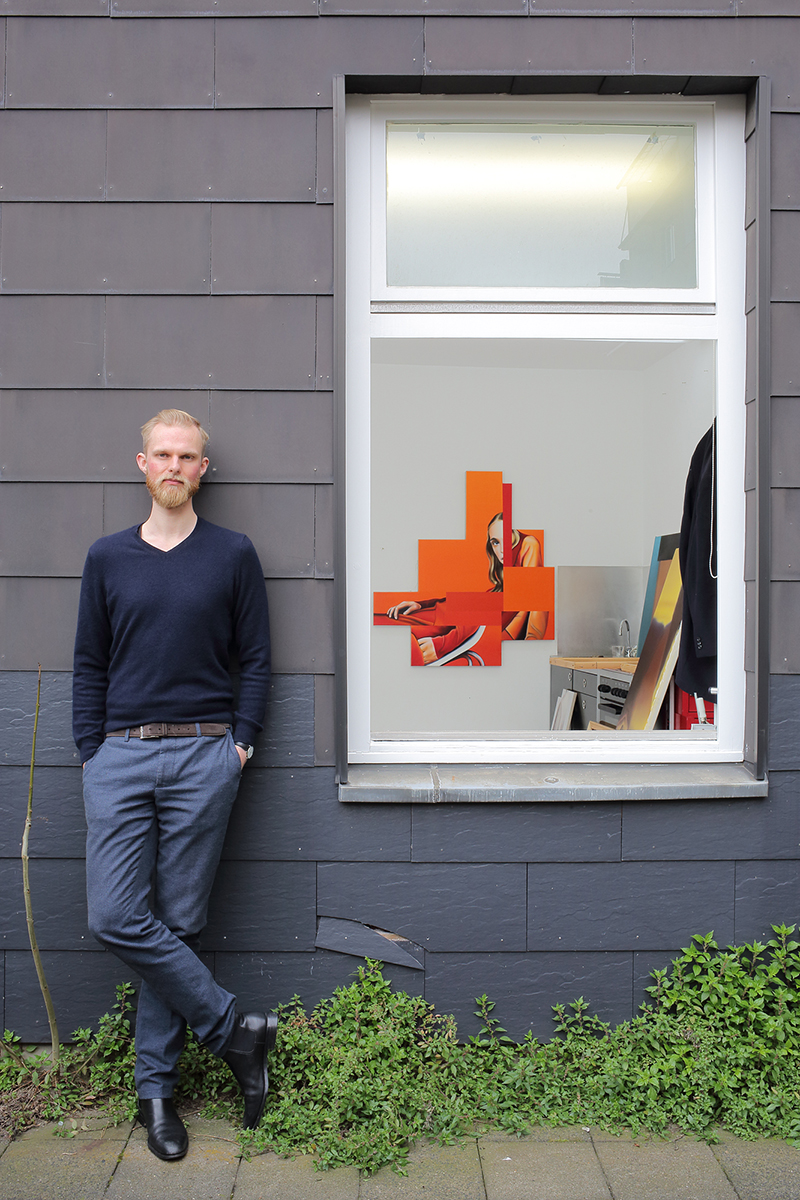
Photo by Greogor Guski. 2019.
Please tell us a little about yourself. What brought you to the world of art and how did you start?
Actually my interest in art began in school around the age of 14. Starting with drawing, spraying, and acrylic painting, I made my first oil painting when I was with 18 – a self portrait, which was quite a classical and mythological start. I was always interested in simulation. So, it was my quest to find out how I could paint a certain surface like metal, plastic, gradients of a sky and so on. I was also interested in specific structures. So, on one hand there was a figurative, painterly interest in objects and on the other hand an interest in understanding abstract compositions.
I began to learn more about this at the Kunstakademie Düsseldorf and the Acadamy of Art in Vienna, where I took the masterclass in abstract painting. In Düsseldorf, my professor Eberhard Havekost taught me that our society nowadays was more influenced by digital surfaces, like smartphones, advertising or Photoshop simulations rather than natural objects. Hence, my interest veered towards digital surfaces and I try to combine them with analog oil paintings. This is what I do now.

Shaped Figure. Kunstverein Mönchengladbach. 2019.
What is the primary role of an artist? How do you describe yourself in the context of challenging people’s perspectives via your work and art?
Besides my time at art school, I also studied philosophy to clarify my diffused or blurred view of my art. Philosophy helps me to find certain abstract structures in terms of thinking. So, it always begins with finding the right questions for a specific topic. In this context, I also see my art similarly, because I want to find the right questions and not the right answers. So, my aim could be that a person, who is seeing my art, is also thinking of different or even the same questions as I did as far as living in the digital age is concerned.
How do you deal with the conceptual difficulty and uncertainty of creating work?
Most of my work is prepared in photoshop with detailed simulations for the next series. It’s a tool, where all photos and ideas get together – maybe like an alchemist in the past.
The uncertainty now is mostly about realising a new series. After working with, say, 40 or 50 different versions of one painting, I select the best one, defining the sizes on a digital wall and thinking of combinations with other paintings. When the creative part is done, most of the time in the studio is just “painting” based on the ideas I had before.
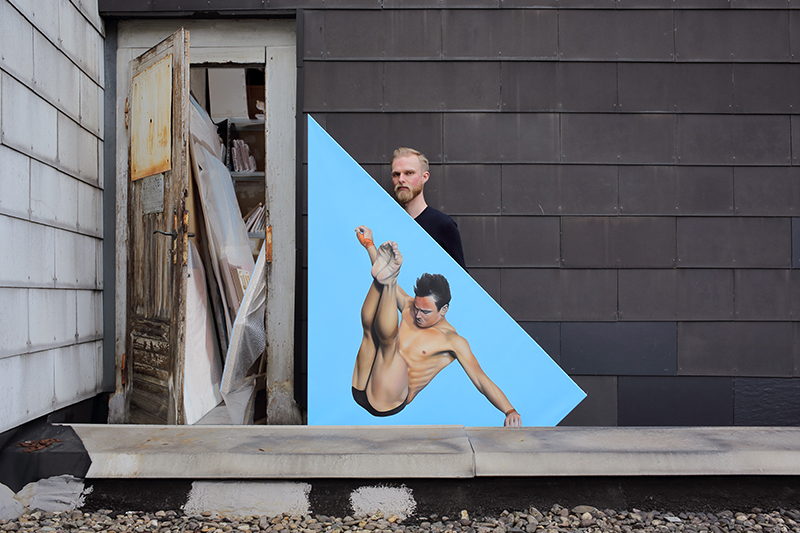
Photo by Greogor Guski. 2019.
Is there any topic lately that you would like to be mentored on?
From an abstract viewpoint the same topic transforms when seen through different perspectives. I would like to refer to our digital viewing habits and its impact on society. The question that concerns me is, what is an image in the digital age and how do we perceive reality?
What would you call your style?
My works are now an analog repetition of digital visual fragments.
Let’s talk about the evolution of your practice over the years. Tell us about your commitment to your current medium.
I am interested in the relationship between analog and digital surfaces. Oil is my favourite medium because I am convinced that it still offers the most attractive form of simulation. And at the same time it has a historic background that I really like. So my “medium” lies between digital image shifts in photoshop and the manufactured work with oil on canvas.
Let’s talk about your artistic journey. What were your biggest lessons and hurdles along the way?
Here I would like to remember something my professor said to me: Learn to disappoint the viewer.
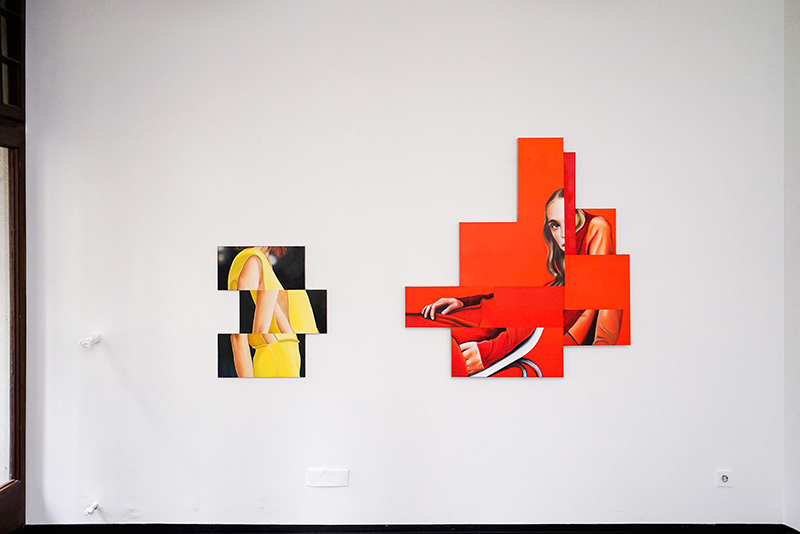
Shaped Figure. Kunstverein Krefeld. 2019.
What are you looking for when you look at other artists’ work? Who are your maestros?
When I am visiting an exhibition of old masters I am really interested in the technique of painting. So, you see me analysing the work like a surgeon with a scalpel. I want to understand the composition, the layers of paint and the questions the artist had.
How do people react to your work?
In terms of people, who see my paintings for the first time, it would be nice if they have more questions after a visit. It is like philosophy – you have to think of the right questions and not the answers – and if my art is like an incentive to rethink visual simulations, that would be a satisfying idea.
What was your first sale? Do you handle the commercials yourself or is it outsourced to a gallery or an agent?
It depends on which projects I am involved in. Is it a commercial exhibition in a gallery or is it a show at a Kunstverein, where a curator invited me? Besides that, I really like to stay in contact with the people who are interested in my art – talk to them and trying to understand them.
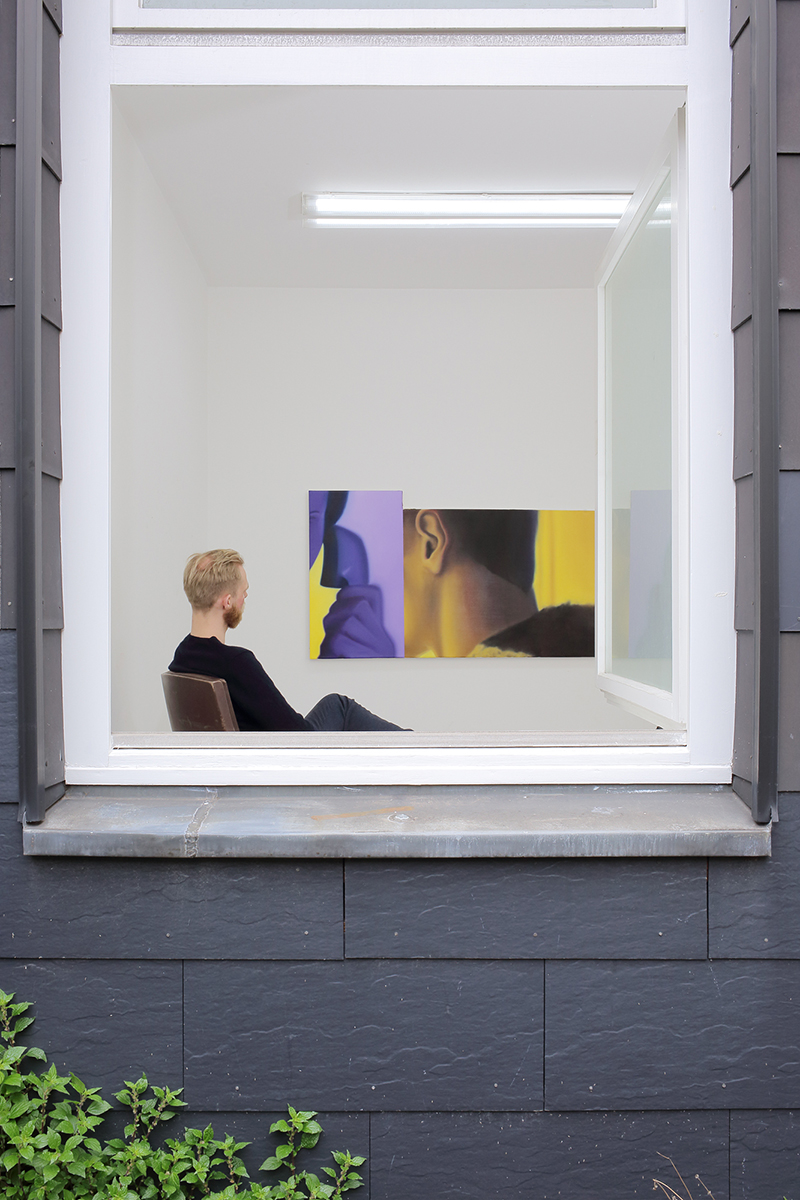
Photo by Greogor Guski. 2019.
Think of the biggest professional risk you’ve taken. What helped you take that risk?
I would describe myself more as a person who loves security, rather than being risky. But at the art academy my aim was to try everything out before you start with your own stuff. So, how far you can create something from your “person” and how does that have a link to you or your idea of the world interested me. For example my graduation show was a mix of wall installations, video screens, abstract acrylic paintings and figurative oil paintings. I wanted to show all kind of variations in my work, before trying to combine them, like now.
What is the best piece of advice you have received?
I consider what Gerhard Richter once said as important:
Painters and just about everyone should paint from photos.
Tell us about your studio. Could you describe your usual work day in the studio?
My studio should be as clean as a new project in photoshop. So, on the one side I have different tools, like the sidebar of a computer screen, and some basic materials like a specific canvas from Netherlands or saws for the shaped forms. There are two roll containers with assorted brushes and an arsenal of oil paints. Besides that, what is really important to working in flow is my hi-fi installation of Danish speakers which are incidentally called Dali!
The duality: artists often experience contradicting motivations when it comes to the commercial and the creative. How do you strike a balance? How does your interaction with a curator, gallery or client evolve?
My motivation is to produce good art and if somebody helps me with it, like a studio visit with curators, galleries or artist friends, then it’s great. But if I get the feeling that somebody is just interested in earning some money, then I become suspicious.

Shaped Figure. Kunstverein Mönchengladbach. 2019.
Let’s talk about your frameworks, references and process. What inspires you?
Photographic templates often form the starting point of a material transformation – a painterly return of digital information to the physical, real world. So, one framework is definitely the digital image and the shifts, which I prepare on the computer and ultimately implement picturesquely. I want to extend the classic format of an image, and translate the composition onto a shaped canvas. The newly created picture sways between geometric abstraction due to the new image format and figuration due to the displayed image content.
I really like Elsworth Kelly, Hans Hartung, Félix Edouard Vallotton and the not very well known Hans Emmenegger. They also have a very interesting balance between digital simulation and painterly transformation, which I really love.
Are you more of a studio artist or naturally collaborative by nature? How do you feel about commissions?
I really like to work with other people. When I lived in Vienna, I had a super time sharing a studio with two architects, dealing with simulations for buildings. In Düsseldorf I work with students, producing, discussing and understanding contemporary art. This helps me a lot. At the same time I really enjoy working alone in the studio in Düsseldorf, listening to old school hip-hop and just painting.
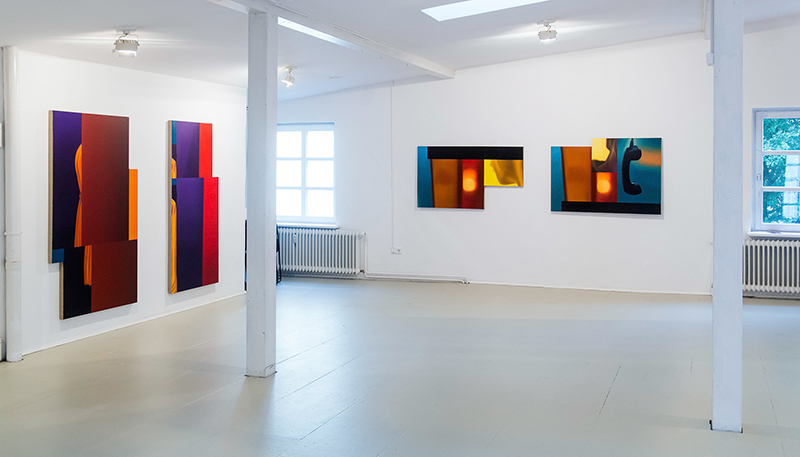
Zuschnitt. Kunstverein Flensburg. 2019.
What are you working on now? What’s coming next season?
In March 2020 I will be involved in a group show in Hamburg curated by Evelyn Drewes. In April 2020 there will be a solo exhibition with a young gallery in Wuppertal called Friedrich+Ebert. There is an interesting project in the summer in Düsseldorf, which I cannot tell you more about right now. And for the next few months there are plans to exhibit in Spain and the UK. So, I am really looking forward to the future.
Before you go – you might like to browse our Artist Interviews. Interviews of artists and outliers on how to be an artist. Contemporary artists on the source of their creative inspiration.








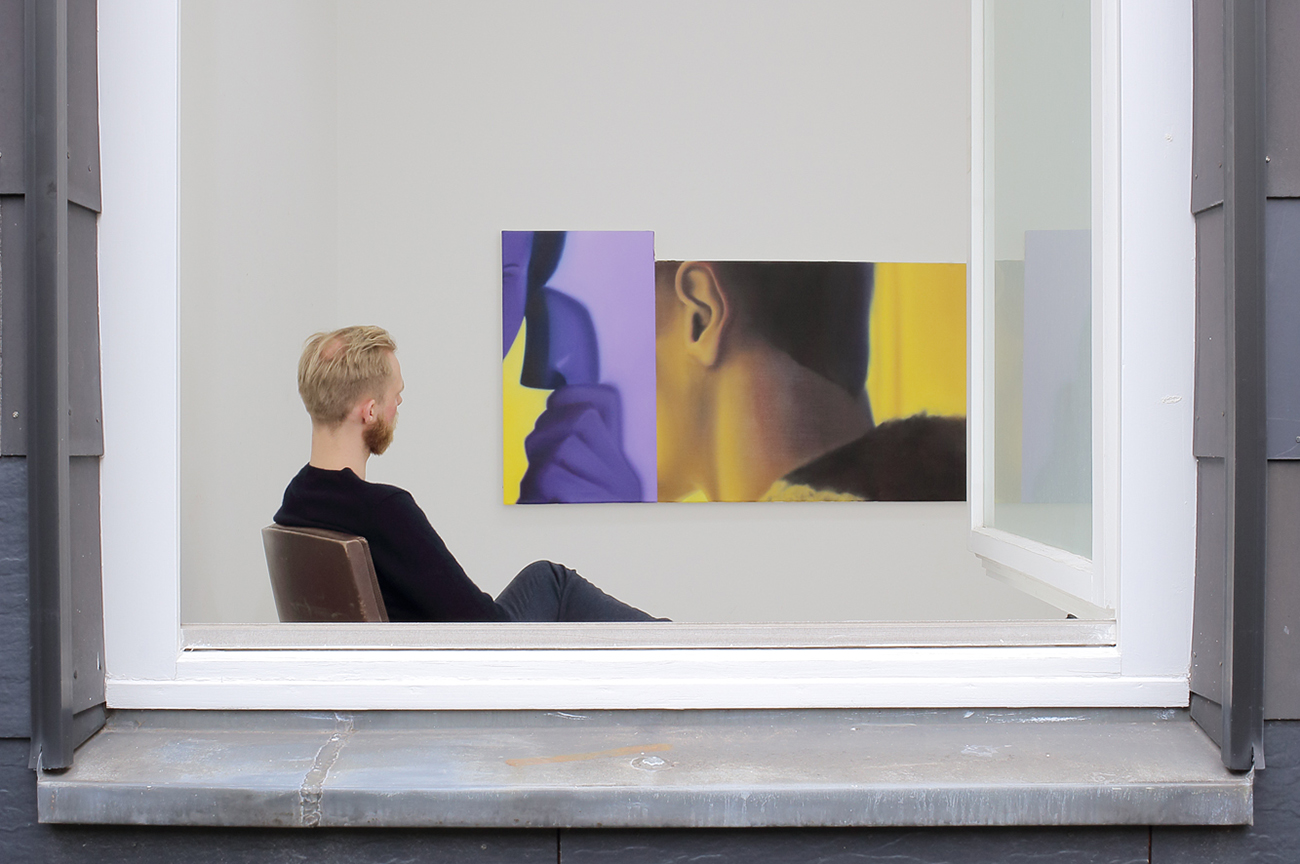



Add Comment